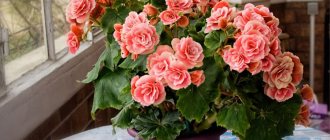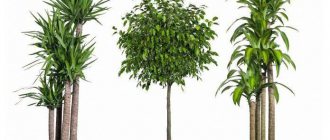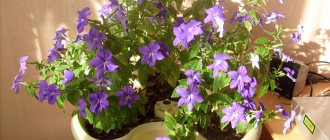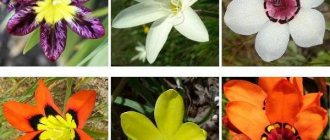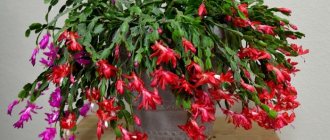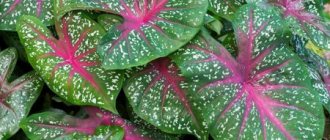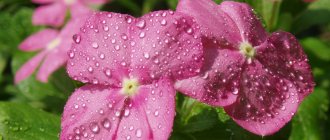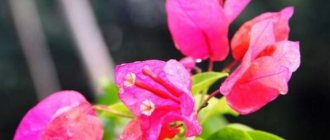Gloxinia indoors has many fans; they form clubs, hold exhibitions, publish catalogs, and exchange experiences and planting material. This is not surprising - the flowering plant looks so impressive that it immediately makes you fall in love with it. There is terry gloxinia with simple corollas similar to velvet gramophones, monochromatic, speckled, edged along the edge. At the same time, caring for the crop is not difficult, and it blooms long and luxuriantly.
Gloxinia or Sinningia
There are two separate genera in the Gesneriaceae family:
- Gloxinia, growing in northwestern South America;
- Sinningia, originating from the tropics of Brazil.
From a botanical point of view, they are close, but not identical.
Some species have been transferred from genus to genus, including Sinningia speciosa. It was she who became the ancestor of the popular indoor flowers all over the world, known as gloxinia. This is not a scientific, but an established name for varieties and complex hybrids obtained by crossing Sinningia the Beautiful with other natural species.
Several representatives of the genus Sinningia are found in culture, but they are not called gloxinia.
Plant care
Both true and floristic gloxinia (sinningia) come from South America and require the same conditions.
Lighting requirements
Gloxinia is not capricious in terms of lighting requirements. It grows well in diffused light. But it can also be cultivated in partial shade, although the flowers will be smaller.
The recommended length of daylight during the period of bud formation is 12-14 hours.
I keep gloxinia on the north-west windowsill. I noticed that here she feels even better than in a more illuminated place. Irina Petrova, Samara. 3 years of experience in growing gloxinia.
The plant should be protected from direct rays of the sun. Therefore, a flower standing near a south window will need shading.
Signs of a lack of lighting are elongated shoots, pale leaves. You can compensate for the lack of light by lowering the temperature.
During the dormant period, the gloxinia tuber does not require lighting.
Description and characteristics of the plant
Species Sinningia Beautiful or Beautiful is endemic to Brazil. It has several varieties that easily cross with other species. It is a herbaceous perennial plant up to 45 cm high with a short stem.
The leaves are thick, juicy, dark green, oblong to ovate, covered with thick hairs, wrinkled. The length and width depend on the growing conditions and are about 8-25 and 3-15 cm, respectively.
Flowers are from 3 to 6 cm, open in summer. They look like a bell, collected in 2-3 pieces. The corolla consists of a medium-sized tube and a violet or lilac, rarely (in varieties) white, red asymmetrical limb with five petals.
The underground part is a modified thickened shoot (tuber) without a bottom or protective shell, with several growth points and thin adventitious roots. In Sinningia the Beautiful it is irregularly round in shape, flattened at the poles.
The species looks much more modest than the varieties or hybrids, and blooms less profusely. Dwarf species of Sinningia took part in the creation of miniature gloxinias, which have been especially popular recently:
- Concinna (Sinningia concinna) with tiny purple flowers;
- Conspicua (S. conspicua), distinguished by creamy white corollas.
Hybrid gloxinia is much more beautiful than the species; it blooms profusely from March to August; some varieties, if properly cared for, last until September or October. The corollas reach a length of 10-12 cm.
The color of the petals is usually rich, monochromatic or combined, white, pink, scarlet, blue, purple. Only yellow is missing in the color scheme - this is why gloxinia looks like a violet. The inside of the corolla is usually colored differently, often covered with dark speckles.
An adult plant can produce 10 buds at the same time.
Gloxinias are divided into groups according to the size of the bush:
- standard – socket 20 cm or more (Yesenia);
- compact – plant diameter 12.5-20 cm (Gloxinia Cleopatra);
- mini – leaf span 5-12.5 cm (Marshmallow);
- microminiature varieties - up to 5 cm (Victory Parade).
All gloxinias fall into a state of deep dormancy in the fall. The above-ground part of the flower dries out completely, and after 2-3 months it resumes growth from dormant buds on the tuber. Without division, with proper care, it can live up to 10 years, increasing in size every year.
Gloxinia Royale is not listed in plant taxonomy, even as a synonym, but Sinningia regina is among the unconfirmed (doubtful) species.
Group of varieties of gloxinia Avante, Avanti
A good example is Gloxinia Avante or Avanti. This group of varieties includes many color options. Most often, gloxinias of this variety are offered in the form of seed sets for self-cultivation. Mature plants have a compact leaf rosette, against which simple velvety flowers seem even larger and more impressive.
The most common Avanti hybrids include gloxinia:
- Avanti Light Violet;
- profusely blooming white, with wavy edges Avanti White;
- with light lilac or bluish flowers, decorated with a wide white wavy border Avanti Blue with White Edge, or Blue lace;
- Scarlet, with velvety wine-red Avanti Scarlet flowers.
Selection rules
Collectible plants are not found in retail chains, unless the owner or seller of a small shop is engaged in growing flowers himself. There you can usually buy Dutch or greenhouse-grown stamping.
Industrial gloxinia is much easier to care for at home than collectible gloxinia, and is often no less beautiful. Beginners are recommended to choose this one.
When purchasing, you should inspect the bush. The leaves must be fresh and elastic, without damage, stains, plaque, or other marks that may remain from careless handling, diseases or pests.
The next obligatory sign is that the plant has many buds that have not had time to bloom. When potential owners need a specific color, it is better to take a gloxinia that has at least one flower open.
It is better to refuse to buy a plant you like if the tuber is not visible. It was planted incorrectly or did not have time to develop the underground part in a volume sufficient for the gloxinia to survive in the winter.
A good sign is that the tuber is buried no more than 2/3 into the ground, the rest is on the surface, elastic, without signs of spoilage.
Author's varieties or hybrids are purchased by:
- at exhibitions;
- via the Internet on professional websites.
If you purchase a gloxinia tuber, you need to make sure that it is not wrinkled, cracked, coated with any color, rotten or spotted. It is better to take it at the end of winter or beginning of spring - just before planting.
What to do with a flower after purchase
The vegetative plant is quarantined for at least 2 weeks. You need to water gloxinia especially carefully at this time, do not expose it to direct rays, and regularly inspect to see if previously unnoticed signs of pests or diseases have appeared.
If everything is in order, after 14 days the plant begins to be accustomed to bright conditions, gradually moving to a brighter place. You cannot immediately place a flower pot on a sunny windowsill - the plates will burn and the buds may fall off.
Leafy gloxinia cannot be replanted.
When a tuber of poor quality is purchased online, you need to try to correct the situation:
- Dry, wrinkled ones are wrapped in a damp cloth and inspected periodically. Gloxinia should be planted when the surface has straightened out a little, but no later than after 3 days. You can’t immerse it in water or wrap it in cellophane - the tuber will suffocate and definitely won’t germinate.
- Rotten areas are cut out, dried during the day, and soaked for 30 minutes in a solution of foundationazole or other fungicide. Let it dry, sprinkle the wound with crushed coal.
If more than half of the tuber has rotted, and dark spots or veins are visible on the cut, you can only throw it away.
How to care for gloxinia
Caring for gloxinia at home is rated as easy with little difficulty. The main problem is to properly store the tuber during the dormant period.
Watering and air humidity
During the flowering and active growing season, plants need regular and abundant irrigation. The soil in a pot with gloxinia should dry out only 1-2 cm; it is important to prevent stagnation of water or souring of the substrate. The liquid is removed from the pan after 20-30 minutes.
The plant can be watered from the bottom as well as from the top. But in the latter case, water must not get on the tuber or leaves. The liquid should be soft, at room temperature.
After all the buds have withered, from late summer or early autumn, irrigation is gradually reduced, and when the above-ground part of the flower dries out, it is reduced to a minimum. Be careful not to overdry the tuber.
Young gloxinia, which has not had time to grow the underground part, grown this season from seeds or cuttings, continues to grow during the dormant period. It is watered carefully but regularly so that the root or young small tuber does not dry out even for a short time.
Leafy plants need high humidity at all times. But you cannot spray water on the plates or flowers:
- liquid from the velvety surface takes a long time to evaporate;
- putrefactive processes may begin;
- if direct sun hits the water drops, there will be a burn;
- ugly whitish marks that cannot be erased from the hair-covered plates will definitely remain.
To increase humidity:
- splash air around the flower;
- place bowls of water next to them;
- wet pebbles are placed in the tray;
- buy a household humidifier;
- Place the pot with the plant in a larger pot, and fill the gap with wet sphagnum.
Lighting and temperature
Daylight hours for the plant should be 12-14 hours a day - if it is shorter, few flowers will form. The sun needs to be bright, but without direct rays at midday. Windows in an eastern or western direction are suitable; in the south, in the middle of the day, the gloxinia is covered with a light curtain.
If the flower is happy with everything, the stem is short and the plates are directed horizontally. When there is not enough light, the leaves and shoots of the plant stretch upward.
The recommended temperature in summer is about 20° C, it is advisable that it does not go beyond 18-25° C. In hot weather, you need to increase the humidity in the room, ventilate it more often, and turn on the air conditioning. In winter, the optimal temperature for a flower is 10-12° C.
Gloxinia should not be taken outside or onto the balcony in summer. The plant does not like drafts, standing in front of a fan or under a stream of air from an air conditioner.
Feeding
From spring until the end of flowering, gloxinia must be fertilized. The first 2 times, if the leaf apparatus does not grow quickly enough, you can use preparations for ornamental foliage plants diluted twice as much as indicated on the package.
Then apply specialized fertilizers for violets according to the instructions. Complete mineral fertilizers are also suitable for flowering crops, but they need to be diluted 2 times more and used every 7-10 days.
After the formation of buds stops, the plants are not fertilized.
How to care during flowering
After the first wave of flowering, which lasts about 2 months, gloxinia is cut off, leaving a column with 2-4 lower leaves. Feed with a mineral complex for decorative deciduous crops.
Stepchildren will begin to form in the axils; they are removed, leaving the 2 strongest ones, otherwise the plant becomes too dense, but the buds are formed weakly and small. They provide fertilizer for violets.
Growing gloxinia of some varieties and hybrids does not require pruning - they produce flowers continuously until autumn. The signal for surgery should be the absence of buds.
Care during the rest period
When the plant stops blooming, in late summer or early autumn, gradually reduce watering. By the time the leaves and stem dry completely, they need to be reduced to a minimum so that the tuber does not dry out, and the above-ground part should be cut off, leaving a stump of 1-2 cm.
If a mature plant does not want to go to rest, despite reducing watering, the owners will have to trim the leaves themselves.
The tubers can be left in the pot or taken out, cleaned of soil and placed in peat or sand. They are stored at a temperature of 10-12° C, or in the vegetable section of the refrigerator, on a glassed-in loggia. As a last resort, the pot with gloxinia is placed under the bath - it is cool and humid there.
The soil in the container or substrate where the plant tubers overwinter should be carefully watered occasionally. They should not rot or dry out completely.
First-year flowers do not retire, they require normal maintenance, only fertilizing is done once a month, watering is less. The plant is illuminated for up to 10-12 hours per day.
Gloxinia begins to be brought out of hibernation at the end of January or beginning of February. The older the plant tuber, the longer it should rest.
Awakening a flower, step by step:
- Remove the gloxinia from the pot or bag, shake off the substrate, remove dry adventitious roots, and rinse so that the tubers can be clearly examined.
- If necessary, peel to living tissue, dry, treat with crushed coal or fungicide.
- Place in a plastic bag with a small amount of moist, fertile soil.
- Bring the temperature to 25° C, provide lighting for at least 10 hours a day.
- After the sprouts appear, plant the gloxinia in fresh substrate.
It is recommended to monitor the tuber - the plant may wake up on its own and produce long, elongated, whitish stems.
Gloxinia F1 Avanti. Gloxinia "Gavrish" Avanti F1 Light purple, 5 seeds
Gloxinia Avanti F1 Light purple
A luxurious and very fashionable indoor plant among gardeners from the Gesneriaceae family. The earliest flowering series among non-double gloxinias. The flowers are bell-shaped, light purple with a dark center, with a pleasant velvety surface, crowned with long peduncles. Widely oval leaves on short petioles adorn the base of the peduncle. An adult plant produces 10-15 large flowers, creating the impression of an elegant bouquet.
Agricultural technology
Gloxinia prefers bright, sunny places without exposure to direct sunlight. The ideal temperature for growth is 20°C - 25°C during the day and 18°C - 22°C at night. During flowering, abundant watering, weekly fertilizing, and moist air (spraying from a spray bottle) are required. In October-November, after flowering, watering and fertilizing are stopped. When the gloxinia leaves dry, the tubers are removed from the soil and placed for storage in shallow boxes with slightly damp sand or perlite, which are installed in a room with a temperature of 10-12°C. After a dormant period (approximately 90 days), the tubers will sprout new shoots and can be replanted in the pot. Seeds for seedlings are sown on top of the substrate (without being buried in the soil) from February to March, covered with glass and placed in a warm, bright place. Shoots appear at a temperature of 22-24°C, after 10-14 days. In the 3-leaf phase, the plants are planted and after a month they are planted in separate pots. Gloxinia grown from seeds blooms in 9-10 months.
How to replant gloxinia at home
The operation is recommended to be performed annually. It is not necessary to take a new pot, but the substrate needs to be changed, even if it seems good, and the flower has spent the winter in a flowerpot.
Choosing soil and pot
A wide, low bowl is suitable for the plant, usually with a cross-section of up to 12 cm, with several holes in the bottom for water drainage. Drainage is required. Some gardeners prefer to transplant gloxinia into a regular-shaped pot, with a diameter 4-6 cm larger than the tuber, and pour a lot of expanded clay on the bottom. This way it will produce flowers faster.
The soil for gloxinia needs slightly acidic, light, permeable soil. Ready-made mixtures “Violet” or “Begonia” are suitable. You can make a substrate for the plant yourself from disinfected components:
- leaf soil - 3 parts;
- peat – 1.5;
- sand or vermiculite – 1.
Planting gloxinia in heavy soil leads to rotting of the underground part.
Transplantation process
As soon as a sprout appears on the tuber, the flower is planted in fresh soil:
- Drainage is placed at the bottom of the pot, and a layer of substrate is placed on top.
- A gloxinia tuber is placed in the center.
- Cover with soil so that after compaction, half or a third rises above the ground.
- Carefully water the flower into the tray.
- When water comes to the surface, remove excess liquid.
- Cover the pot with the plant with a transparent film and expose it to the light.
- Contain gloxinia at 20-25° C and high humidity.
When 2 leaves appear, leave the flower covered only overnight to protect it from temperature changes. After 5 days, the cellophane is removed completely.
The soil
For planting gloxinia, the ready-made soil mixture “Violet” is suitable; these plants have similar requirements for the substrate. It should be loose and nutritious.
It is not difficult to prepare the ground for synningia yourself. It is necessary to mix high-moor peat, humus and coarse sand (vermiculite) in a ratio of 1:2:1.
For the flower, heavy ceramic pots are used of such a size that the tuber occupies two-thirds of the volume. The presence of drainage holes in the bottom of the pot is necessary.
Appearance
During the period of active growth and lush flowering, gloxinia is watered regularly, preventing the substrate from completely drying out. It is enough to water the soil well once every 3 days.
Important ! Excess water that has flowed into the pan must be drained. Stagnant moisture can lead to rotting of the flower roots.
Water for irrigation needs to be soft (tap water is left to settle) and warm.
During flowering, gloxinia needs high humidity, but you should not spray water on the leaves and flowers. Plates of water placed near flower pots will correct the situation. A decorative tabletop fountain or waterfall looks aesthetically pleasing.
From September, the plant is prepared for a dormant period, gradually reducing the frequency of watering.
Fertilize flowering gloxinia every 10-12 days with a mineral complex for Saintpaulias (Fertika, Pokon). With the onset of autumn, feeding is stopped.
During the autumn, when the tops of the flower have completely withered, they are cut off, leaving a 2 cm piece of the stem. The pot is put away in a dark and cool place until February. The earthen ball needs to be watered once every 2 - 3 weeks, not too much.
Gloxinia is transplanted in February, before the flower awakens. The pot is selected in such a size that there is 3 cm of space between the tuber and the walls. Expanded clay or crushed brick must be placed at the bottom of the container as a drainage layer.
The roots of the transplanted flower are carefully inspected, cutting off damaged or rotten areas. Healthy exposed tissue is sprinkled with crushed coal. The gloxinia tuber is covered three-quarters full with substrate.
Reproduction methods
Indoor gloxinia flowers are not difficult to propagate, but only if everything is done correctly. The best time for vegetative propagation of plants is late spring or early summer, especially for varieties or hybrids that require pruning after the first wave of flowering. Then you can grow gloxinia from “waste”, and the vegetative organs are already mature enough to take root and produce offspring.
After flowering in the fall, the plant prepares to retire; life processes die out. Reproduction of gloxinia after the end of the buds, as a rule, ends in failure.
Leaf
The most common method of propagating a flower. You can grow gloxinia from a whole plate or a fragment of a leaf taken from the middle tier of a bush. The old ones, the lower ones, finish their life cycle and, at best, give birth to few children. The upper ones, the young ones, will first put out roots and continue their own development; only when they reach maturity will they begin to produce offspring.
The leaves of the plant are rooted whole:
- in perlite;
- light substrate;
- vermiculite;
- peat;
- sand;
- water.
They can be divided into fragments by removing the thick central veins, dried and rooted. Sometimes cuts are made on the gloxinia plate, pressed to the substrate, secured to ensure better adhesion, and covered with glass or cellophane. Babies will appear from every wound. When the rosettes grow a little, the tiny gloxinias are transplanted into small plastic cups with light soil.
If, after separating the children, the leaf plate or its fragments are fresh and elastic, you can update the sections and re-root.
stem
The “extra” pieces of shoots remaining after the first wave of gloxinia flowering are cut, dried, and rooted in water or a light substrate. Such a plant will produce flowers faster than children obtained from a leaf.
By dividing the tuber
It is recommended to propagate gloxinia from tubers with a diameter of at least 6 cm, healthy, with several growth points. After the plant emerges from the dormant period, they are divided into parts so that each has at least 1 bud or an already hatched stem.
The cut is dried and treated with crushed coal or fungicide. They are planted, not completely buried, in a light substrate, and watered very carefully.
Seeds
Gloxinias are sown in spring on the moistened surface of steamed peat. They don't sprinkle it. Cover with glass or transparent film and keep at high humidity and temperature. Remove the cellophane after the sprouts appear, pick up the plants in the phase of 2 true leaves.
Gloxinia seeds with simple flowers of various colors are usually sold under the name “mix”.
Problems during cultivation
The plant's immunity can be considered average. Owners may encounter difficulties:
- pale plates – nutritional deficiency;
- buds fall off from dry air, drafts, temperature changes;
- no flowers – the plant is too young, violation of the rules for storing tubers, gloxinia “missed” the dormant period;
- spots on the leaves remain from water;
- large whitish marks on the plates – sunburn;
- Gloxinia tubers rot during wintering due to an excessively wet substrate;
- dry out due to lack or too little watering;
- The leaves of the plant rise from the heat, and fall when the temperature is low.
The owners should be alarmed by the fact that deep notches have appeared on the edges of the sheet plates. Gloxinia lacks boron, which is especially dangerous for the bulb. Make a 2% borax solution and water once.
Varieties
Gloxinia Kaiser exists in two types - Wilhelm and Friedrich.
Gloxinia Kaiser Wilhelm and Kaiser Friedrich are very compact indoor plants, with beautiful, rich, deep shades of flowers. The first has a dark purple color, or as it is also called “night” color, while the second is painted in a delicate crimson color. The first and second plants have a white border along the edges of the flowers, and the leaf blades are dark green with an emerald tint.
Important! The flower of these varieties has one feature - they can hibernate, that is, remain dormant for a certain time! If you are interested in the varieties and types of gloxinia, it will be useful to read the following articles telling about their diversity:
- Decorative gloxinia Sonata.
- The most beautiful Gloxinia Shagane.
- Hybrid gloxinia.
- Description of the Krasnoyarje and Red Riding Hood varieties.
- Climbing gloxinia vines.
- Charming Gloxinia Brokada.
- Gloxinia Rosalinda.
- White terry gloxinia.
- Gloxinia Pink.
Diseases and pests
Root or gray rot appears on the plant due to heavy watering at low temperatures. Treatment is to remove the affected tissue and treat with a fungicide. You may need to replant; sometimes you have to take healthy shoots or leaves for rooting and throw away the flower.
Gloxinia plants suffer from pests:
- spider and cyclamen mites;
- thrips;
- aphids.
They will have to be controlled with appropriate insecticides. If scale insects or mealybugs appear, it is easier to discard the plant.
Winter “sleep” and storage of gloxinia tubers in winter
At the end of November, with decreasing daylight hours, Sinningia stops blooming and gradually dries out. After the above-ground part dies, the tubers are dried at room temperature and placed for winter storage in a dark and cool place, but not in the refrigerator. The best temperature for storage is +10. +16 °C, at a lower temperature the tuber may freeze, at a higher temperature it may “wake up”. To save space, you can store the tubers in a zip bag.
All collectors have different storage methods: wrapped in a napkin, in vermiculite, in coconut substrate, peat, Seramis granules and even in sawdust. You can store the tubers in pots, but make sure that the soil does not dry out and water them with water at room temperature at least once a month, otherwise they will dry out and die.
Twice a month they check the condition of the tubers and make sure that condensation does not settle on the bags. The dormant period lasts about 3 months depending on storage temperature.


